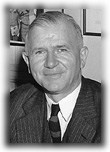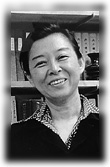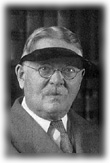
Introduction
100th Anniversary Issue
Centennial Harvests:
The College Pump
The Readers Write
The Undergraduate
Harvard Portrait
Bulletin Boards
Boom and Bust: 1919-1936
War and Peace: 1937-1953
Baby Boom to Bust: 1953-1971
Century's End: 1971-1998
Centennial Sentiments
Harvard Magazine
Universities' reverence for the individual remains one of their persistent charms. Harvard surely is institutional--witness its many faculties and registration forms and Byzantine finances. But you relate to its individuals: the professor who excited you about art, the scientist who guided your dissertation, the House master who encouraged your coming of age.
 Bingham
Bingham |
 Pian Photograph by Christopher Morrow
Pian Photograph by Christopher Morrow |
 Pound Photograph by John Brook
Pound Photograph by John Brook |
The Harvard Alumni Bulletin focused fully on the individual face of the community on September 28, 1946, when it published the first of 96 numbered "Harvard Portraits." Under a close-up photograph, 21 lines of type explained the work of Belgian-born George Sarton, historian of science. Much of what those portraits portrayed resonates still. They explored the rise of new devices and disciplines (chemist Louis Fieser and napalm, number 34; short-wave physicist and Nobelist Edward Purcell, number 88). They probed the internationalism of the intellect (the exodus of professors from Europe before World War II, and the travel, even then, to remote outposts for research and conferences). But time has undone certain certainties of those days. Treasurer Paul Cabot (number 54) feared a future with fewer of the "legacies and gifts which made possible Harvard's large endowment fund." Nor must all Harvard teachers and administrators now wear tweed jackets and ties, estivate in the White Mountains or along the New England coast, or be white men.
Reborn as "Professors in Action" in 1957, the feature loosened up, introducing more personal information (Oscar Handlin is "an accomplished bassoonist"), and, at the eighth in the new series, a woman: anthropologist Cora A. Du Bois. In the late 1960s and early 1970s, having assumed their current form, the "portraits" are fully of this world, as is Harvard: Health Services psychiatrist Paul A. Walters Jr. counsels on drug use; Ewart Guinier breaks the color barrier among profilees; Wallace T. and Isabel Gamble MacCaffrey appear as the first tenured couple; Adams House master-designate Robert Kiely and his children practice yoga and "watch the news every evening while standing on their heads."
In sustaining the series today, the magazine keeps faith with one of Harvard's greatest virtues: the special worth of each of its people.
~ The Editors